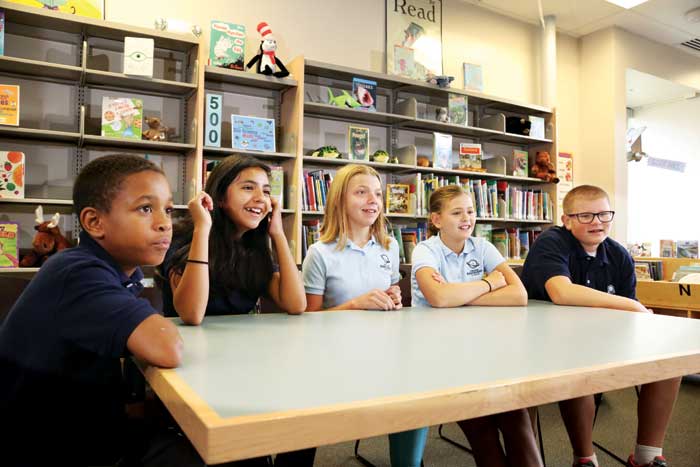
Sixth-graders at Denver Discovery left to right: Donovan Battle, Ashley Rubio, Hannah Vagi, Maggie Piturro and Maddox Friesen.
If you wonder whether kids know more about the digital world than you, there is no debate. They do. A group of five sixth-graders from Denver Discovery were part of a discussion about social media and technology. At one point during the interview, the adults in the room could not register something about Twitter, and a student advised the others, “Pretend you’re talking to a 5-year-old.”
Eleven- and 12-year-olds are among the bubble of kids who have grown up with a digital life. Social media and technology are second nature. “It can kill your brain cells, but it’s an important skill,” Donovan Battle says.
The students agree having a phone is necessary for ages 10 and older. Hannah Vagi says her parents got her a phone specifically so she could experience a digital childhood.
Other students say their parents bought them a phone going into middle school to keep track of their busy schedules. Maggie Piturro’s mom has an app that tracks Maggie’s location.
Their instant access to information on phones and laptops is both good and bad, they say. “We have the World Wide Web at our fingertips,” Maddox Friesen says. “But everything you put on social media is there forever.”
“It makes all homework easier, and seriously homework is mental abuse,” Ashley Rubio says. “Scientists say that it stresses kids out.”
They are able to find answers to math problems online. Hannah Vagi only uses her phone to check her answers, but somehow her mom always seems to walk in while she’s on her phone and assumes she’s cheating. “I’m doing what I’m supposed to be doing. A lot of kids don’t. I consider myself a good child.”
“You can easily abuse the Internet,” Piturro adds. “Some kids cheat on homework. But say you are checking your homework and find you have the wrong answer. Would you change it without doing the work?”
At school, phones must be turned off and stored in lockers. Soon they will have Chromebooks, or PC laptops. A couple of the students launch into a debate whether Google or Microsoft has touchscreen laptops. They return after a few minutes.
Besides checking homework, the group uses their phones for games and texting. But, the biggest use is Instagram. Even mentioning the word makes them all squawk at once. For the older readers, Instagram is a way to share photos and videos with friends. The app has filters to make photos capture a certain mood or look more professional.
“I Instagram Fall Out Boy, Taylor Swift and my selfies,” Rubio says. She is a social media expert. At times, even other students in the group don’t understand what she is saying.
She has had an Instagram account for almost a year and has 1,445 followers. Number of followers and likes do matter, she says. She tracks her number of ghost followers, or users who don’t like or comment on any photos.
She explains a few tips about social media etiquette: Selfies (photos you take of yourself) are appropriate if it’s taken in a significant place (Mount Rushmore, Leaning Tower of Pisa, with Taylor Swift, etc.). Selfies driving to the mall, at the mall, and buying something at the mall are not OK.
Two is a good standard for hash tags. Her example: “In the library having an interview for the Front Porch #awesome #interview.”
Facebook is apparently for older people. Except for one, all of the students don’t have Facebook and are waiting to get an account.
All five of the students have to explain things about phones and social media to their parents. Usually parents get it. Piturro is her mom’s resource for phone questions. “And that’s why I think I should have the iPhone 6 and she should have the iPhone 5, but no,” she says and laughs.


0 Comments